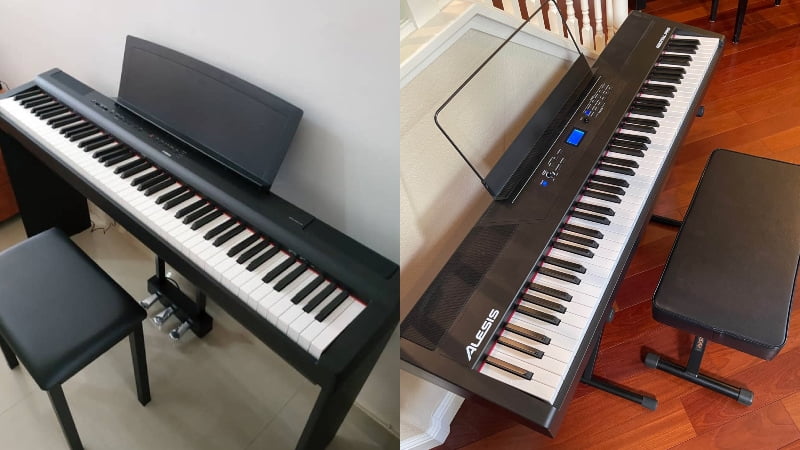The Alesis Recital Pro is one of the favorite beginner digital pianos on the market. It comes with all the features you’ll need, a great sound library, and is available at a very affordable price. But in this Alesis Recital Pro vs Yamaha P125 comparison, the Yamaha model came out on top?
How did the Yamaha beat out the Alesis Recital Pro?
Well, the Yamaha P125 came with a much richer sound library, a wider range of effects, and judging by the ear test, had superior tone and voice quality compared to the Alesis Recital Pro. Granted, the Yamaha P-125 is significantly more expensive than the Recital Pro (over twice the price!), but considering the sheer quality of this piano, it’s easy to understand why it’s more expensive.
When testing out both pianos, I found that the Yamaha P125 was better in almost every aspect. On top of that, the “downsides” to the Recital Pro simply didn’t exist on the Yamaha P125. However, the Alesis Recital Pro was able to put up a pretty fair fight against the P125, which made this comparison very interesting.
Alesis Recital Pro vs Yamaha P125: Comparison Chart




Last update on 2025-04-18 / Affiliate links / Images from Amazon Product Advertising API
Alesis Recital Pro vs Yamaha P125: The Differences
To determine a winner between these two great pianos, I decided to compare all the features. And as expected, the more expensive Yamaha P125 beat out the Alesis Recital Pro in all aspects with a score of 3-1. But don’t let this lopsided scoreline fool you, as we dive deep into the details and features of both these pianos, you’ll learn how close of a fight it actually was. But while the Alesis model put up a good fight, it just couldn’t compete with the top-quality voices and realistic feel of the Yamaha P-125.
Feel & Playability
The winner: Yamaha P125
In the world of digital pianos, it’s very hard to compete with the hammer action of Yamaha, particularly their GHS or graded hammer system. This is the main reason the Yamaha P-125 won out over the Alesis Recital Pro in terms of feel. However, the Alesis Recital Pro still had surprisingly good hammer action for its price, despite the lackluster key texture.
+ Hammer Action
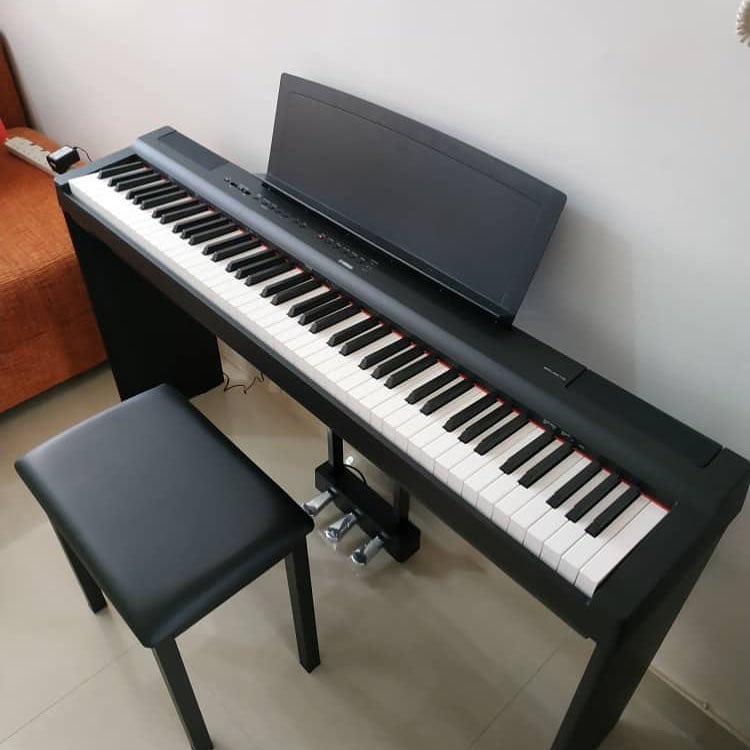
As mentioned earlier, the Yamaha P-125 is equipped with the GHS of Yamaha. This is a hammer action system designed to properly replicate the feel of an acoustic piano. So, with this model, you have heavier keys on the bass notes that get lighter as you progress up the piano. There are other models in this price range and lower that offer a similar hammer action set up, but after testing out the P-125 and other Yamaha models that have GHS, I found that Yamaha offers some of the best hammer action in the digital piano market today.
With that said, for its price, I was actually surprised that the Alesis Recital Pro had progressive hammer action. On top of that, the hammer action on the Alesis Recital Pro was pretty accurate, with heavier keys on the left and lighter ones on the right. However, after trying out the piano, I found that the action paled in comparison to the Yamaha P-125.
+ Key Texture
To be honest, I was let down by the key texture of the Yamaha P-125 and Alesis Recital Pro. Both of these pianos are equipped with plastic piano keys that don’t have any coating on them whatsoever. The result is fairly slippery keys that can make it hard to play faster and more advanced pieces. Granted, you won’t really notice the glossy texture as a beginner, but as you progress with the instrument, the difference becomes glaring.
With all that said, it was easier to forgive the lackluster key texture on the Alesis Recital Pro since it was the cheaper model. Glossy keys are a common quality of most entry-level pianos, which is why I was pretty disappointed that the Yamaha P-125 didn’t have any coating on them to simulate real wooden keys, especially considering its price.
+ Touch Response
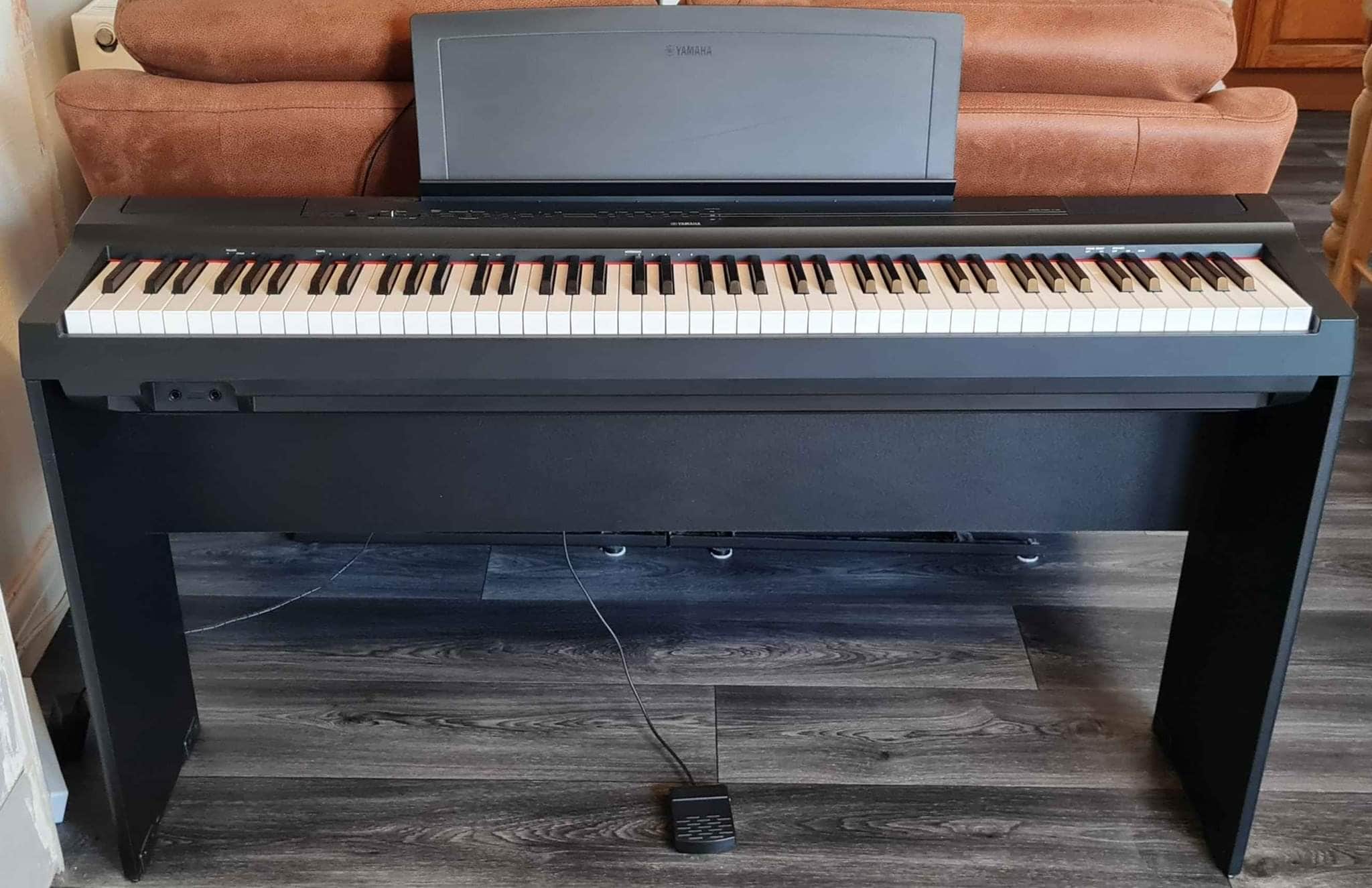
Both of these pianos have the same adjustable touch response, which was a great feature to have. That way, you can adjust the piano according to your own touch, making for a more customized and tailored feel. Both pianos allow you to choose between hard, medium, soft, and fixed touch response. However, I noticed that the Yamaha P-125 was more sensitive and offered more subtle details whenever you press down on the keys, which is why it was ultimately the winner in terms of feel and playability.
Tone
The winner: Yamaha P125
One of the main reasons the Yamaha P125 has a higher price tag is because of its tone. When I first tried out both these pianos, the Yamaha P-125 had better quality tones than the Alesis Recital Pro, hands down. While they both use a similar tone generation technique, the voices on the Yamaha P-125 were more realistic, and considering the fact that it has a wider sound library than the Alesis Recital Pro, it was very easy to determine the winner between the two.
+ Tone Generation
In terms of tone generation, the Yamaha P-125 was a clear winner. It’s equipped with the Yamaha PureCF sound engine, which is largely considered one of the best tone engines in its price range. While it still uses samples just like some of the other mid and entry-level pianos on the market, Yamaha recorded samples from their own CFIII concert grand pianos, which are some of the most popular grand pianos in the world of classical music. So, the Yamaha P-125 captures the incredible clarity and distinct brightness of many Yamaha pianos, making for very realistic piano voices.
On the other hand, the Alesis Recital Pro sticks to standard sampling techniques. Since it’s their entry-level model, it isn’t equipped with the AiR tone generation you might find on some of the more expensive Alesis models. With that said, the samples on the Recital Pro are still fairly high quality and are much better than a lot of the options in its own price range.
+ Sound Library
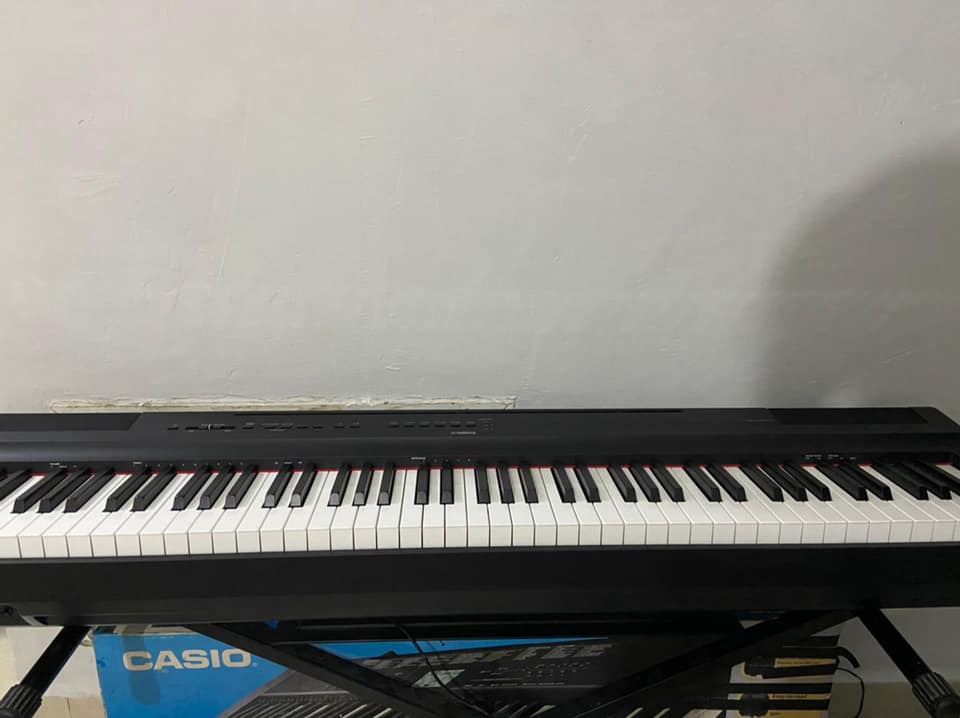
The Yamaha P-125 has double the amount of voices as the Alesis Recital Pro. Since the Yamaha P-125 is the more expensive option between the two, you can expect it to have a better sound library. While the Alesis Recital Pro only has 12 built-in voices, the Yamaha P-125 has 24 different voices all at your disposal. The sounds on both pianos fall under similar categories such as electric and acoustic pianos, synths, organs, and even some strings and bass voices. However, the main difference is the variety you have on the P-125.
Since the P-125 has a more varied sound library, it’s also the more versatile model between the two. When you’re a beginner, you might benefit from lesser voices, which is why the Recital Pro is a popular choice for a first digital piano. However, as you progress, you’re going to need more variety to find the right sound that reflects your personality and style, which is exactly what you’ll find on the Yamaha P-125.
Piano Features
The winner: Tie
One of the areas where I couldn’t decide on a winner between the two was in terms of piano features. Both the Yamaha P125 and the Alesis Recital pro came with a bunch of different features, effects, and other characteristics that would make them great fits for any pianist. In fact, both of these models have the exact same playing modes and offer a very similar range of effects, which is why they were tied in this category.
+ Playing Modes
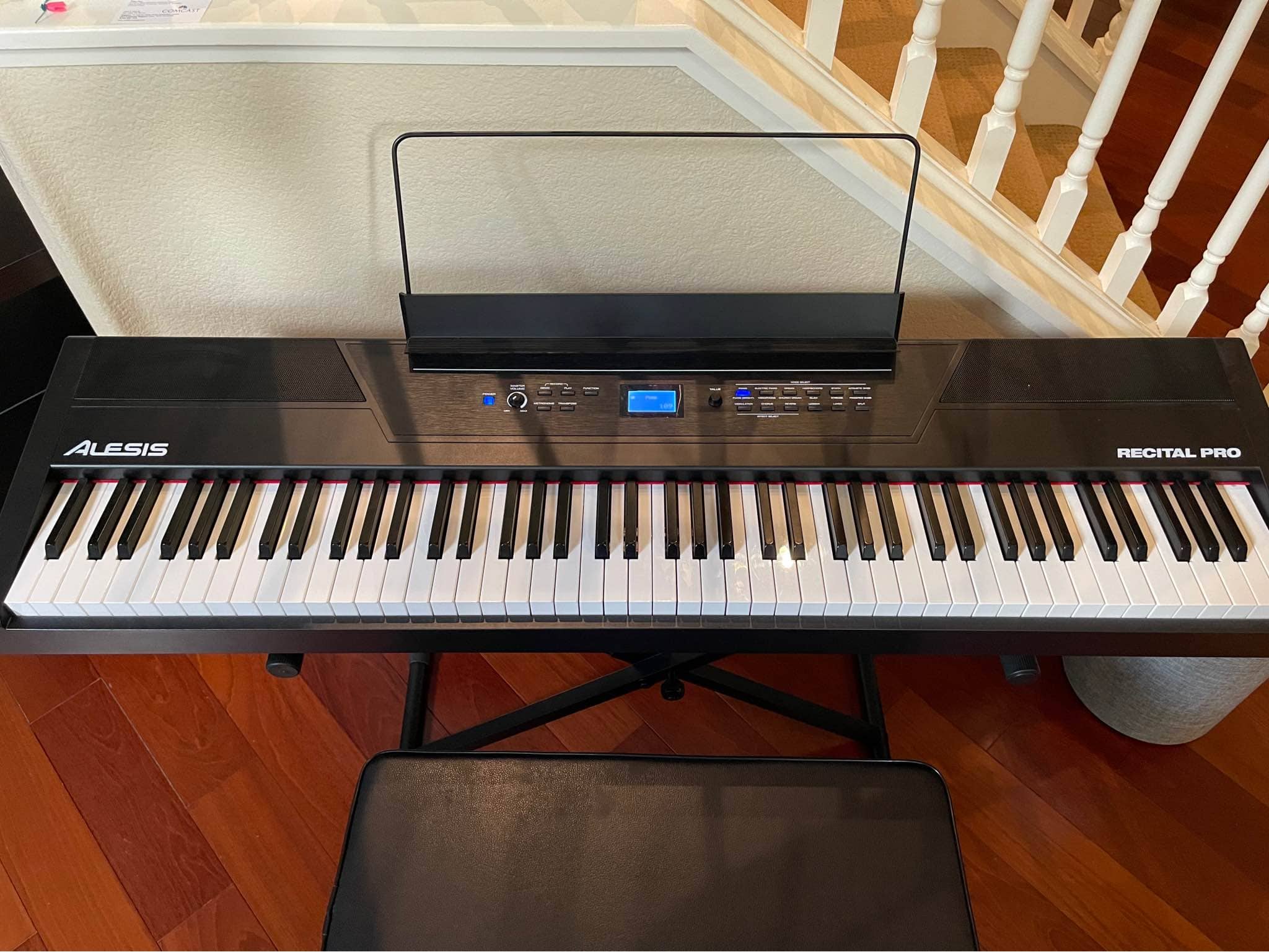
As I mentioned earlier, both of these pianos come with the same playing modes. These modes are: split, dual, and duo mode. As a pianist, you’ll probably find a ton of different applications for all these features, which is what makes both of these models legitimate workhorses that can work for both beginners and novices alike.
With split mode, you can divide the piano into two different zones with different voices. For example, you can load a bass voice on the left side and a piano voice on the right side. From there, you can play walking bass lines on your left hand while piano comping with chords on your right hand. It will sound like there are two people playing different instruments, when in reality, all the sounds are coming from one musician.
With dual mode, you can blend two different voices together. This gives you a unique tone that you won’t be able to find anywhere else. On top of that, you can even tweak the mix level of the different layers in this mode, giving you a lot of control over your tone. This is very useful for accompanists and people who like experimenting with different sounds and allows for a whole lot of experimentation.
With duo mode, the piano is separated into two mini keyboards with the same voice. This is designed for piano lessons or duets, so that each side has the exact same tuning. That way, the teacher can play along and demonstrate different piano techniques to the student without crossing over to each other’s side.
Additionally, both pianos offer recording modes. That means you can record your own playing and listen back on it to determine areas of improvement. However, the Yamaha P-125 does this slightly better as you can record two tracks as opposed to only one track on the Alesis Recital Pro.
+ Connectivity
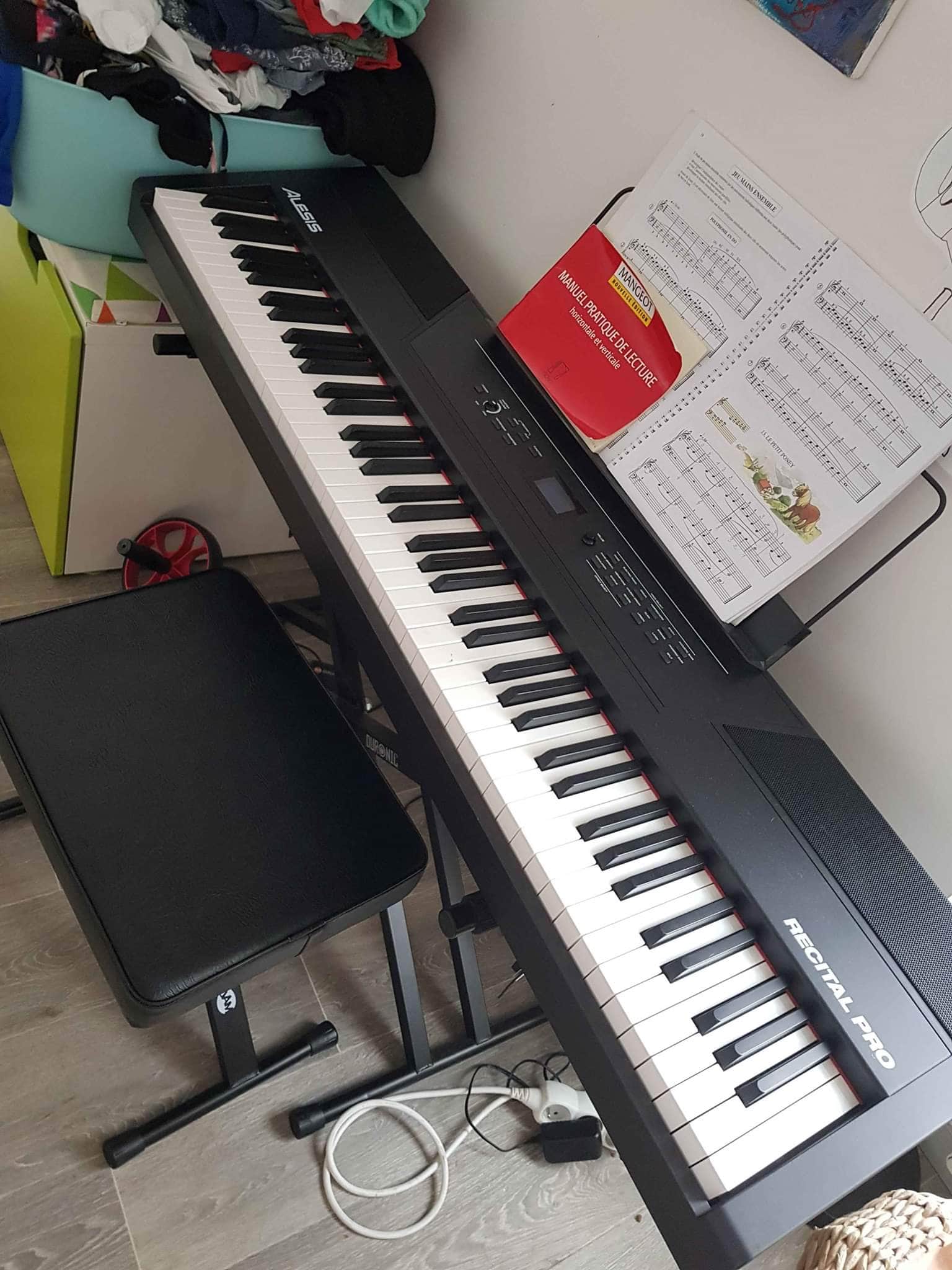
Both of these models offer MIDI connectivity, which is a huge plus. The reason this is a very valuable feature is that you can connect the pianos to your computer via a USB to control virtual instruments or use piano learning apps that use MIDI. However, the one downside to both of these pianos is that they don’t offer BlueTooth MIDI connectivity. While it isn’t a requirement, BlueTooth MIDI can eliminate the need for wires, which can greatly help with organization.
+ Polyphony
The Yamaha P-125 has a maximum of 192-note polyphony while the Alesis Recital Pro offers 128-note. While the 192-note polyphony may seem much better than that on the Alesis, it actually doesn’t make that much of a difference. Since there are only 88 keys on both pianos, it’s impossible to max out the polyphony while using the standard playing modes.
The real area where this makes a difference is when you’re using the sustain pedal or using dual or split mode. And even then, it can still be hard to max-out the 128-note polyphony on the Alesis Recital Pro.
So, while the Yamaha P-125 definitely has better polyphony than the Alesis Recital Pro, they are still tied in this category because of how little of a difference it makes to your actual playing. With that said, if you want that extra cushion when it comes to polyphony, the Yamaha P-125 offers more versatility and flexibility.
Alesis Recital Pro vs Yamaha P-125: The Similarities
These pianos are in two completely different price ranges and are made by two different brands. With that said, these models still share a fair amount of similarities. For example, the Yamaha P-125 and Alesis Recital Pro are both portable keyboards with 88-keys. This is the same number of keys you’ll find on an acoustic piano, which offer more realism, making both of these options great for novices and beginners alike.
Another major similarity is the playing modes. Despite the higher price tag on the Yamaha P-125, both of these pianos share the same playing modes and a lot of the same piano features, which is a huge point in the Alesis Recital Pro’s favor.
When testing out both of these pianos, the last similarity I noticed was also a point towards the Alesis, and that is the key texture. Whenever I test out digital pianos, glossy key texture is one of the major letdowns for me, which is what both of the models had. However, since the Alesis Recital Pro is the more affordable model, I found it easier to forgive the glossy texture on the Alesis than the Yamaha P125.
While both of these pianos are great options for their price, the Yamaha P-125 offers way more versatility, which is arguably because of the higher price. While the Alesis Recital Pro will serve any beginner very well, the Yamaha P-125 is the better investment because it will probably last you longer on your musical journey.
Quick Rundown Of the Yamaha P125
- A fully weighted digital piano with 88 full sized piano style keys
- GHS weighted action is heavier in the low keys and lighter in the high keys, just like an acoustic piano
- The pure CF sound engine faithfully reproduces the tone of the acclaimed Yamaha 9 feet CFIIIS Concert grand piano; Tempo range: 5 to 280
- Split mode lets you play a different voice with each hand; Tuning: 414.8 440.0 to 446.8 hertz
- USB to host connectivity with MIDI and audio transfer means you only need 1 cable to connect to your music making software
Last update on 2025-04-18 / Affiliate links / Images from Amazon Product Advertising API
Quick Rundown Of the Alesis Recital Pro
- A Digital Piano That’s Tailored to You - Feature-packed electric keyboard with 88 premium full-sized weighted hammer action keys with adjustable touch response to suit your preferred playing style
- Premium Sounds - 12 voices (Incl. Acoustic Piano, Electric Piano, Organ, Synth, and Bass), built-in FX: Chorus, Modulation, Reverb, and two built in 20W speakers for clear, room-filling sound
- All The Right Connections - ¼” sustain pedal input (pedal not included), ¼” stereo headphone output for private practice and stereo outputs for connection to speakers / amplifiers
- Play the Keyboard Wherever You Go - Power via the included power adapter or 6 D cell batteries (not included) for professional piano performance anywhere
- Powerful Educational Features - Standard, split, layer, record and lesson modes with 128-note max polyphony and Skoove 3 month premium subscription for expert interactive online piano lessons
Last update on 2025-04-18 / Affiliate links / Images from Amazon Product Advertising API
Product Videos
Related Articles to Yamaha P125
- Yamaha P150 vs P125: The Battle of the P-Series Models
- Yamaha P125 vs CLP 625: Can a Beginner’s Digital Piano Match the Clavinova?
- Yamaha P125 vs Roland FP 60: Which is the Better Investment?
- Yamaha P-121 vs P-125: Finding the Best Portable Yamaha Piano
- Yamaha P125 vs Korg LP 380: Which Piano Is Better for Your Needs?
- Yamaha P125 vs P85: Can the Outdated Digital Piano Beat the Newer One?
- Yamaha P125 vs DGX 670: Which Piano Comes Out on Top?
- Yamaha P125 vs Korg SP 280: Which is the Better Beginner’s Digital Piano?
- Yamaha P-255 vs P-125: Finding the Better Option for Beginners
- Yamaha P125 vs YDP S34 Comparison: Does the Portable P125 Hold Up Against a Console Digital Piano?
- Yamaha P125 Vs YDP 164: Should You Get A Console Or Digital Piano?
- Yamaha YDP 103 Vs P125: Should You Get a Portable or Console Digital Piano?
- Yamaha P125 Vs Kawai ES110 Comparison: Which Is The Best Portable Digital Piano
- Yamaha P125 vs Casio PX S1000: Which Digital Piano Is Worth Your Money?
- Casio PX-870 Vs Yamaha P-125: Should You Get A Portable Or Console Digital Piano?
- Alesis Recital Vs Yamaha P125: Which Is The Right Pick For You?
- Yamaha P45 VS P115: Which P-Series Newbie Gives You More Value for Money?
- Alesis Prestige Artist vs Yamaha P125 Comparison: Why the Yamaha P125 Is the Better Investment
- Yamaha P125 vs Casio PX-770 Review: Why the Yamaha P125 Beats Out the Casio Console Digital Piano
- Yamaha P125 vs DGX 660 Comparison: Can the P125 Hold Its Own Against the DGX 660?
- Yamaha P125 vs Roland FP-30X Review: Why the Roland FP-30X Comes Out On Top
- Yamaha P125 vs P515 Review: Why the Yamaha P515 Is the Better Investment
- Yamaha P115 vs P125 Review: Can the P125 Beat Out Its Predecessor?
- Yamaha P125 vs Roland FP30: A Close Battle Between Two Great Digital Pianos
- Yamaha P45 vs P125: Why the Yamaha P125 Is the Better Pick for Pianists
- Yamaha P71 vs P125: Why the Yamaha P125 Is the Better Investment
Related Articles to Alesis Recital Pro
- Alesis Recital Pro vs Williams Legato III: Discover the Best Piano for Your Home
- Alesis Recital Pro vs Roland Go Piano 88 Comparison: Which Is The Best Portable Digital Piano?
- Alesis Recital Pro vs Yamaha NP32 Comparison: Discover the Best Piano for Your Home
- Kawai ES110 Vs Alesis Recital Pro: Should You Shell Out for the Kawai ES110?
- Alesis Recital Pro vs Prestige Comparison: Choosing the Best Entry-Level Alesis Piano
- Alesis Recital Pro vs Casio CDP-135: Which Is the Best Beginner’s Digital Piano?
- Alesis Recital Pro vs Roland FP-30: Finding the Best Digital Piano on a Budget
- Alesis Recital Pro vs Casio CDP-S150 Comparison: Which Is The Best Portable Digital Piano?
- Alesis Virtue vs Recital Pro: Which Piano Offers The Most For Beginners?
- Alesis Recital Pro vs Casio PX 160: Which Piano Comes Out On Top?
- Alesis Recital Pro vs Roland FP 10: Why You Should Go For The Alesis Recital Pro
- Alesis Recital Pro vs Korg B2 Comparison: Which Digital Piano Should You Get?
- Alesis Recital Pro vs Williams Allegro 3 Comparison: Which One Is Worth Your Money?
- Alesis Recital vs Alesis Recital Pro: Should You Invest In The Recital Pro?
- Alesis Recital Pro vs Yamaha P45: Which Should You Get As Your First Piano?
- Donner DEP-20 vs Alesis Recital Pro Comparison: Two Great Pianos Designed for Beginners
- Alesis Prestige Artist vs Recital Pro: Which Is the Best Alesis Piano for Beginners?
- Yamaha P71 vs Alesis Recital Pro: Which Digital Piano is the Best Option for Beginners?
References
- Recital Pro 88-Key Digital Piano with Hammer-Action Keys: https://www.alesis.com/products/view/recital-pro
- Yamaha P-125 88-key Weighted Action Digital Piano – Black: https://www.sweetwater.com/store/detail/P125BK–yamaha-p-125-88-key-weighted-action-digital-piano-black
Lulacruza is an electronic folk duo operating at the junction of the hypermodern and the ancient. Our music weaves together hypnotic female singing, South American folk instruments and electronic processing, while channeling pulsating waves from the source of creation.
Lalucruza is also a community where you can connect with other music lovers to collaborate, exchange ideas and share knowledge. A platform for who wants to learns the basics of playing piano, guitar, drum masters’ technique, etc.. is the premise of our website.
